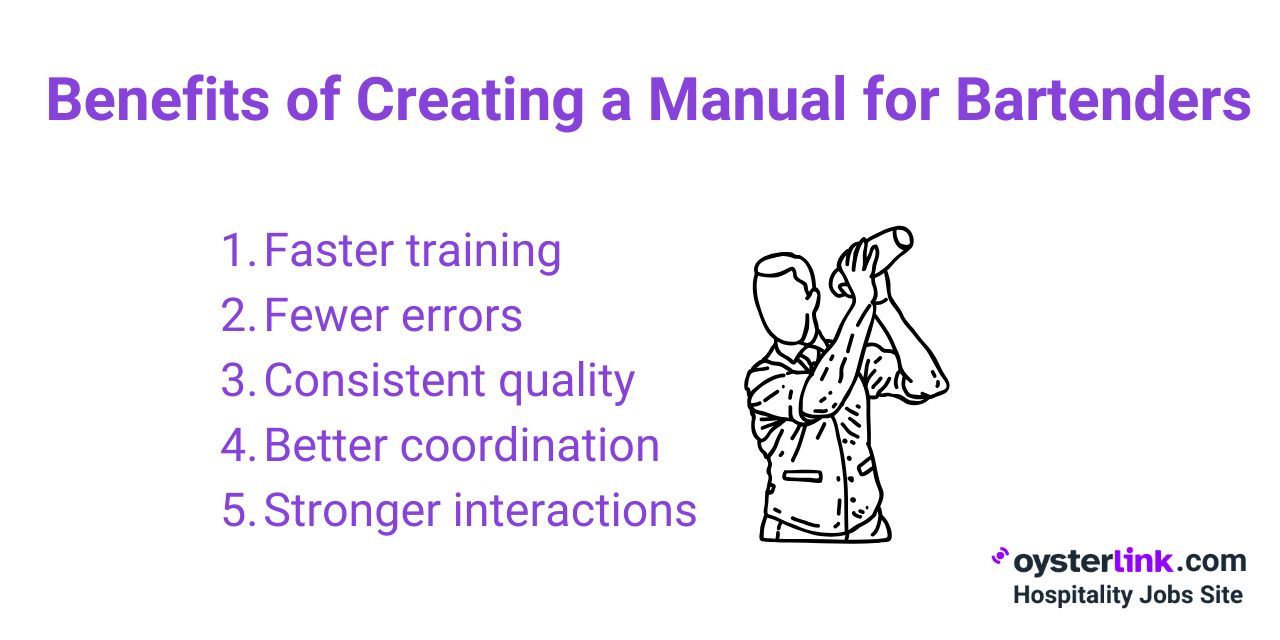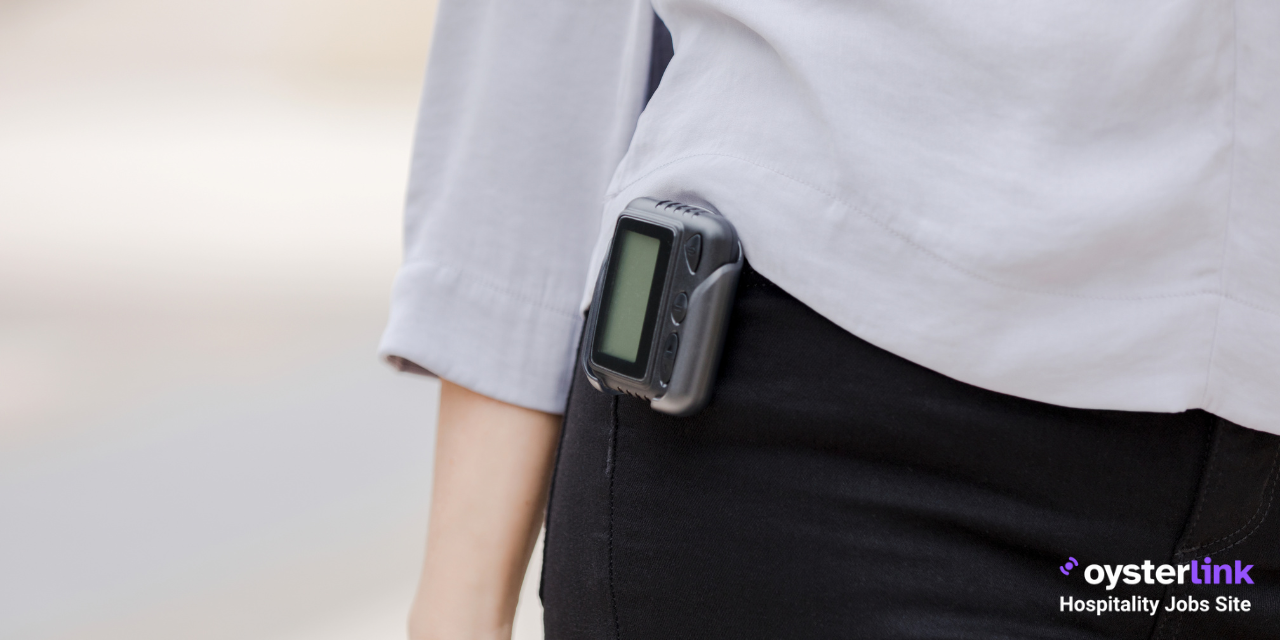A Bartender plays a key role in shaping the guest experience — through precision, speed, product knowledge and great communication. To help new hires step confidently behind the bar, every bar or restaurant needs a clear, structured Bartender training manual.
This template gives managers a repeatable training process that sets expectations, maintains consistency and supports Bartenders as they develop speed, accuracy and rapport with guests.
Benefits of a Bartender Training Manual
A Bartender training manual creates a standardized way to teach drink recipes, service procedures and safety rules. It ensures each Bartender provides the same level of quality and professionalism.
Benefits include:
- Faster training and onboarding
- Fewer errors during busy shifts
- Consistent drink quality
- Better team coordination
- Stronger guest interactions

Bartender Training Manual Template
Use this outline as a step-by-step framework for creating or improving your Bartender training manual.
Each section represents a key area of Bartender onboarding, from setup and service to compliance and communication.
The bullet points under each heading are examples of what to include or train on in that area. You can copy these sections directly, modify them to reflect your bar’s policies and workflow or use them as a checklist when building a fully customized manual.
If you're onboarding a new hire, go through each section in order. Pair the content with demonstrations, tasting sessions and hands-on tasks. Use the checklist in Section 13 to track their progress and confirm when each skill has been completed.
1. Getting Started Behind the Bar
This section introduces the manual and its purpose. It welcomes new Bartenders and explains how the guide supports their role.
Example:
Welcome to the bar team! This manual will help you learn how we do things — from signature cocktails to customer service standards — so you can perform confidently behind the bar.
2. About the Bar & Brand
Explains the venue's concept and the Bartender’s role in creating a memorable guest experience.
- Brand values & atmosphere: What guests expect from your bar
- Bar style: Craft cocktail bar? Sports bar? Lounge?
- Dress code & grooming: Uniforms, cleanliness, hair, piercings, etc.
3. What You’ll Be Responsible For
This section outlines the daily responsibilities and service standards Bartenders are expected to meet. It covers everything from drink preparation to guest interaction and legal compliance.
- Prepare and serve beverages quickly and accurately
- Memorize recipes and drink specials
- Maintain cleanliness and stock levels
- Interact with guests in a friendly and professional way
- Manage tabs and process payments
- Prevent over-serving and follow alcohol laws
4. Bar Setup & Workflow
This section covers how to prepare the bar for service, maintain an efficient workspace during a shift and properly close down at the end of the night. It includes best practices for cleanliness, organization and inventory management.
- Opening checklist: Stock garnishes, juices, ice, glassware
- Station layout: Where tools, bottles, and mixers are kept
- Restocking protocol: How and when to replenish supplies
- Closing checklist: Clean surfaces, drain lines, empty trash
5. Mastering the Menu
This section focuses on developing deep product knowledge — from mastering house cocktails to understanding wine and beer offerings. Bartenders should also learn standard pours, techniques and how to adjust for guest preferences.
- Core cocktail recipes (with specs)
- Beer and wine list overview
- Seasonal or signature drinks
- Mocktails and non-alcoholic options
- Garnish standards and presentation
- POS labels or drink categories
6. Delivering Great Bar Service
Here you’ll find standards for hospitality and guest engagement. From greeting guests promptly to reading the room and recommending drinks, service is about more than speed — it’s about creating a welcoming experience.
- Greet within 10 seconds
- Use guest names when possible
- Offer recommendations or upsells
- Watch for signs of intoxication
- Keep bar clean and welcoming
- Say goodbye and invite guests back
7. Responsible Alcohol Service
Bartenders must serve alcohol safely and lawfully. This section outlines certification expectations, steps for identifying intoxicated guests and how to document and report incidents professionally.
- ID check procedures
- Signs of intoxication
- Steps for refusing service
- Local/state liquor laws
- Reporting incidents
- Designated driver info or ride-share promotion
8. Using the POS & Handling Payments
Bartenders must be comfortable with your venue’s point-of-sale system. This section includes cash handling procedures, splitting checks and closing out tabs with accuracy.
- Entering drink orders
- Opening/closing tabs
- Splitting checks
- Handling comps and voids
- Closing out cash drawers
9. Bar Support & Cleanliness
Cleanliness is key to both safety and presentation. This section provides daily, weekly and shift-specific cleaning tasks, along with expectations for station upkeep throughout service.
- Glass polishing and restocking
- Slicing garnishes
- Refilling syrups, juices and mixers
- Cleaning draft lines and soda guns
- Sweeping, mopping and trash removal
10. Staying in Sync with the Team
Strong communication is essential in a busy bar. This section outlines how to pass along information during shift changes, communicate specials or 86’d items and coordinate with Servers, Restaurant Managers or Barbacks.
- Handoff protocol for tabs and service areas
- Updating 86’d items or special requests
- Using bar logbooks or shift notes
- Radio or headset etiquette (if used)
11. How Success Is Measured
Bartender performance is tracked through a combination of speed, accuracy, cleanliness and guest feedback. This section outlines key metrics used during evaluations and what growth looks like on the job.
- Speed and accuracy
- Cleanliness and organization
- Product knowledge
- Guest feedback
- Compliance with alcohol laws
Set 30-, 60- and 90-day check-ins to track progress.
12. Your Training Journey
This section provides a clear training timeline so new Bartenders know what to expect during their first ten days. It includes mentorship, hands-on learning and formal check-ins to ensure readiness.
Day 1: Orientation
- Meet the team, tour the bar, intro to menu
Days 2–4: Shadowing
- Observe senior bartenders during service
Days 5–7: Assisted shifts
- Make drinks under supervision, handle POS
Days 8–10: Independent service with feedback
- Bartender manages full station with manager support
13. Skill Completion Checklist
Use this checklist to confirm skill completion.
Task | Completed | Trainer Initial | Date |
| Memorized 10 house cocktails | Y/N | ||
| Learned POS system | Y/N | ||
| Completed opening/closing duties | Y/N | ||
| Passed drink quiz | Y/N | ||
| Demonstrated proper ID check | Y/N |
14. Bar Terms To Know
This section introduces essential bar terminology that every bartender should understand. Knowing these terms helps you communicate clearly with staff and guests, work more efficiently, and maintain professionalism behind the bar.
- Neat: Straight, no ice
- On the rocks: Over ice
- Dirty: Olive juice added
- Shake and strain: Mixed in shaker, strained into glass
- 86’d: Item is unavailable
15. Final Words & Sign-Off
This section wraps up the training manual with a note of encouragement and a formal acknowledgment. It reinforces the importance of ongoing growth and accountability as part of the bar team.
Example:
Thank you for being part of our team. Bartending is fast-paced and rewarding, and this manual is your guide to delivering great service every shift. Don’t hesitate to ask questions and keep learning.
Acknowledgment:** I acknowledge that I have received and read the bartender training manual.
Employee Signature: ____________
Date: ____________
Manager Initial: ____________
Final Advice for Training Managers
Effective training isn’t about simply handing someone a manual. It only works if it's reinforced through action. This manual should guide how you train, coach and lead on the floor — not just during the first week, but continuously.
Make it part of your daily operations. Reference it in pre-shift meetings. Tie feedback and evaluations back to what’s outlined in these sections. Treat it like a living document that adapts as your menu, staff and standards evolve.





